Embarking on your golfing journey might seem daunting with a market drenched in titanium clubs and high-tech gadgets. Yet, here’s a refreshing truth—embracing the fairway calls for just a handful of essentials. This guide lovingly unwraps “Golf Equipment For Beginners,” offering insights that strip away the complexity, leaving you poised to revel in that cherished first swing. Let’s set aside the noise and dive into what truly matters as you gear up to make golf a delightful chapter in your story.
Key Takeaways
- Beginners should prioritize forgiving clubs like a driver, hybrids, and cavity back irons for easier swings and better control.
- Two-piece golf balls offer durability and longer distance, while tees improve shot accuracy by elevating the ball.
- Affordable beginner sets often include essential clubs (driver, hybrid, wedges) with graphite shafts for smooth and consistent swings.
- Carry bags or Sunday bags are lightweight options that suit walking players; cart bags work well for those using golf carts.
- Accessories like gloves, towels, divot tools, water bottles, snacks, sunscreen, and first-aid kits ensure comfort during long rounds.
Essential Golf Clubs for Beginners
Starting golf means picking the right clubs. Each one serves a specific purpose, making the game easier for beginners.
Driver
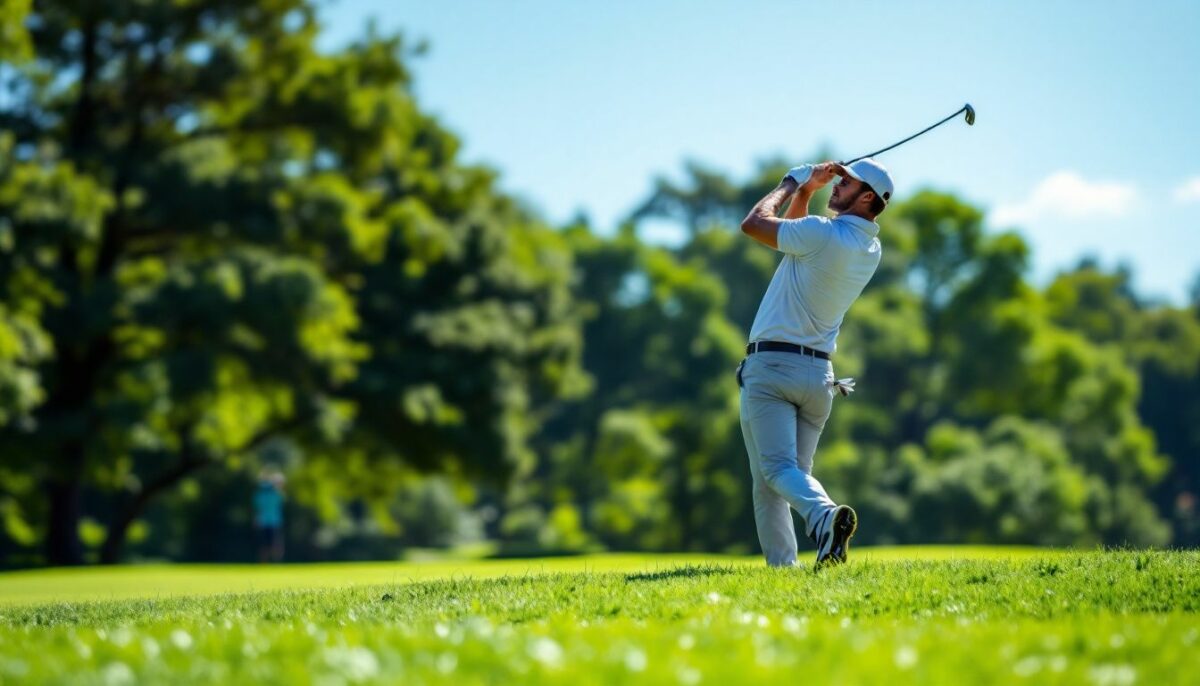
The driver is the longest golf club. It’s designed to hit the ball far down the fairway. Beginners should look for a forgiving driver with a large sweet spot. This helps reduce mishits and keeps shots straighter.
Titanium drivers are popular for their light weight and strength, starting at $75. Graphite shafts are also great options as they offer more flexibility, helping beginners gain better distance.
A good driver can make a big difference on the first tee!
A strong start sets up an easy finish.
Fairway Wood
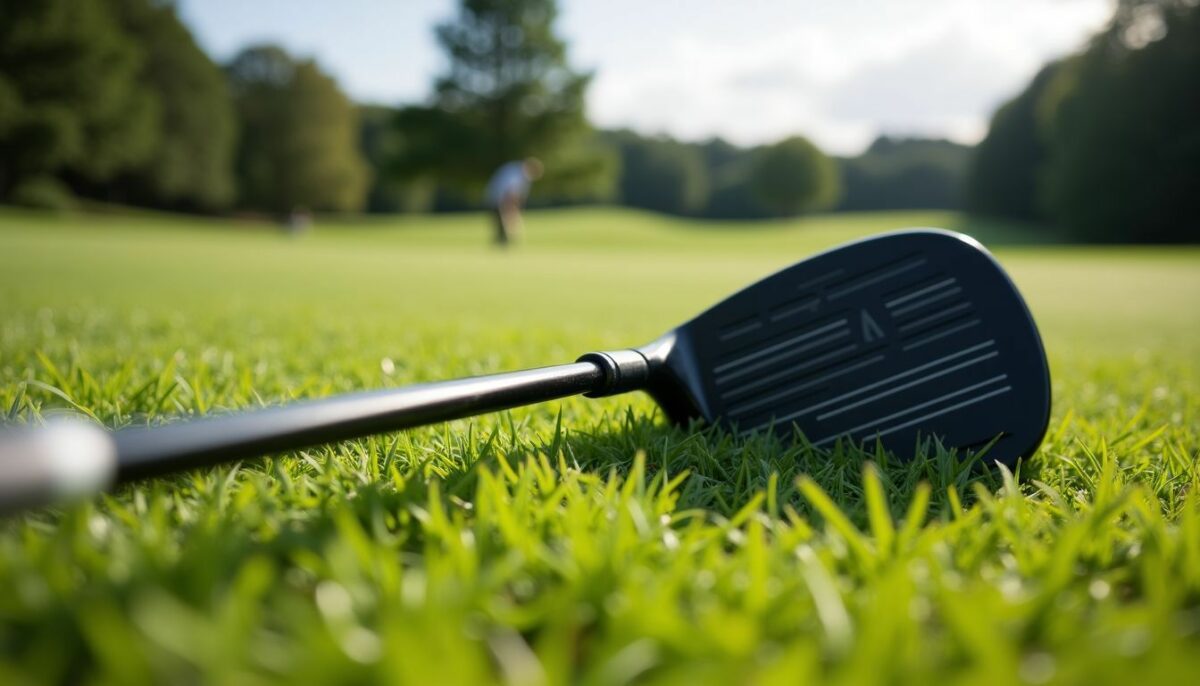
Fairway woods are great for long-distance shots on the golf course. They usually have higher lofts, making them easier to hit. Beginners often find fairway woods forgiving and reliable.
Higher-numbered fairway woods, like the 5-wood or 7-wood, offer better control and more lift.
Cleveland Launcher fairway woods range in loft from 20–27 degrees and are good picks for new players. These clubs can help beginner golfers get the ball airborne with ease. Look for fairway woods with graphite shafts as they provide a lighter feel and quicker swings.
Up next: hybrids!
Hybrid
A hybrid bridges the gap between a fairway wood and an iron. It combines the power of woods with the control of irons, making it ideal for beginner golfers. Its forgiving design helps hit from rough terrain or tight spots on the golf course.
Many hybrids have a sweet spot that makes connecting with the ball easier, even on off-center hits.
Beginners often find hybrids more reliable than traditional long irons like 3-iron or 4-iron. Hybrids with cavity backs are common since they boost confidence and improve accuracy.
Opting for graphite shafts can also help new players get better swing speed without much effort. A good beginner golf set includes at least one hybrid to simplify learning and playing rounds confidently.
Irons (3-4)
Irons (3-4) are great for control and accuracy. They help beginner golfers hit medium to long shots with ease. Cavity back irons, like Cleveland HB Launcher or Ping G425, provide a larger sweet spot.
This makes them more forgiving golf clubs—ideal for players learning the ropes.
A 6-iron can carry about 150 yards, while an 8-iron offers higher loft for shorter distances. Choosing game improvement irons with graphite shafts reduces strain on swings. These irons build confidence without feeling too heavy or stiff in hand.
Wedges (Pitching and Sand)
These wedges fill the gap that irons can’t cover. A pitching wedge, with a loft of 44–48 degrees, is great for short-distance shots onto the green. It helps you control height and distance with precision.
Beginner golfers find it handy for approaches just outside putting range.
A sand wedge shines in bunkers and tricky lies. Its design lets you glide through sand without digging too deep. Consider starting with options like the Cleveland Smart Sole 4.0 S wedge for its friendly forgiveness and ease of use on golf courses.
Putter
A putter is essential for any beginner golfer. It’s the club used on putting greens, where precision matters most. Blade putters offer a classic feel, while mallet putters provide more forgiveness due to their larger heads.
Beginners might find mallet-style options easier to control near the hole.
Affordable options can often be found online or in pre-owned equipment shops. Choosing one that feels comfortable in hand is key since it helps improve strokes and confidence over time.
Pair your putter with practice sessions on a putting green to master short-distance shots effectively!
Golf Balls and Tees
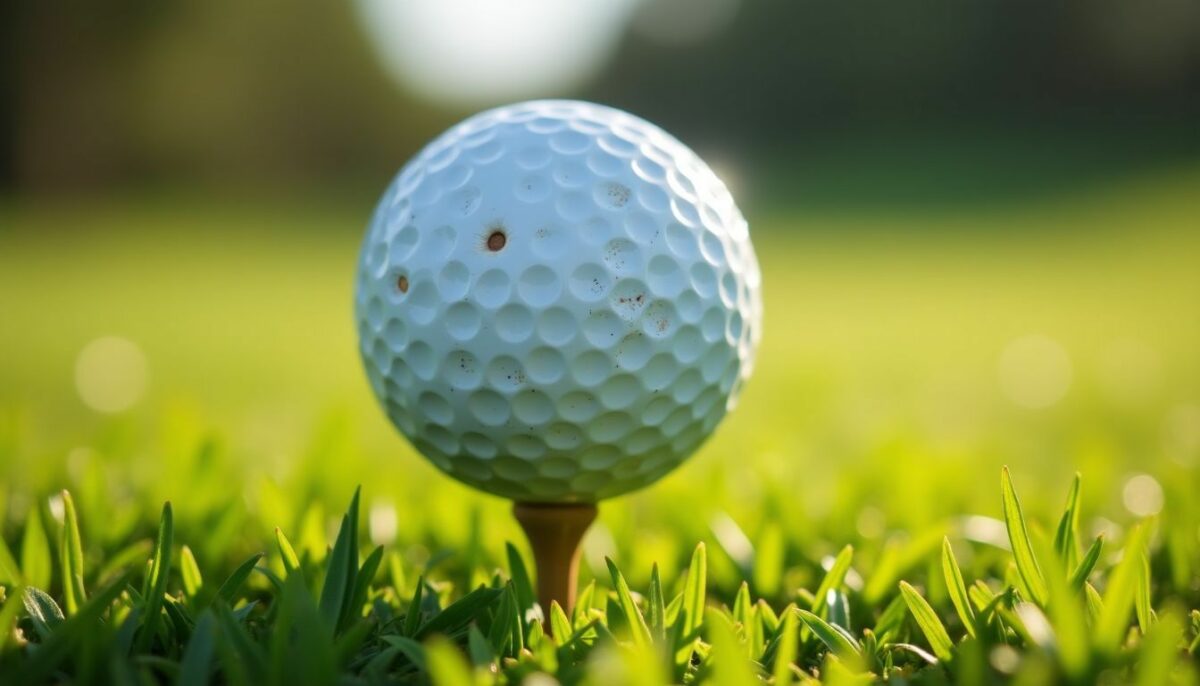
Golf balls aren’t just for hitting—they affect how you play. Tees may seem tiny, but they set the stage for your first swing.
Types of Golf Balls
Two-piece golf balls are the best choice for beginners. They have a solid rubber core and a tough cover, making them durable and easy to hit. These balls offer more distance, even on slower swings, which is great for new players learning the game.
Three-piece balls bring more control but are better suited for advanced players or pros. Brands like Titleist Pro V1 dominate this category. For expert golfers, four-piece or five-piece options add layers for spin and precision during play.
One-piece golf balls exist but rarely appear in modern games—they’re mostly used at driving ranges today.
Importance of Golf Tees
Golf tees give the ball a solid base. They make each shot cleaner and more accurate. Using a tee helps you hit closer to that sweet spot on your clubs, like a driver or fairway wood.
A standard tee is 2.5 inches or longer, which suits most beginners.
Carrying about ten tees in your golf bag keeps you prepared for breaks or losses during play. Tees also reduce ground interference, helping beginner golfers improve consistency on the course.
Golf Bag Options for Beginners
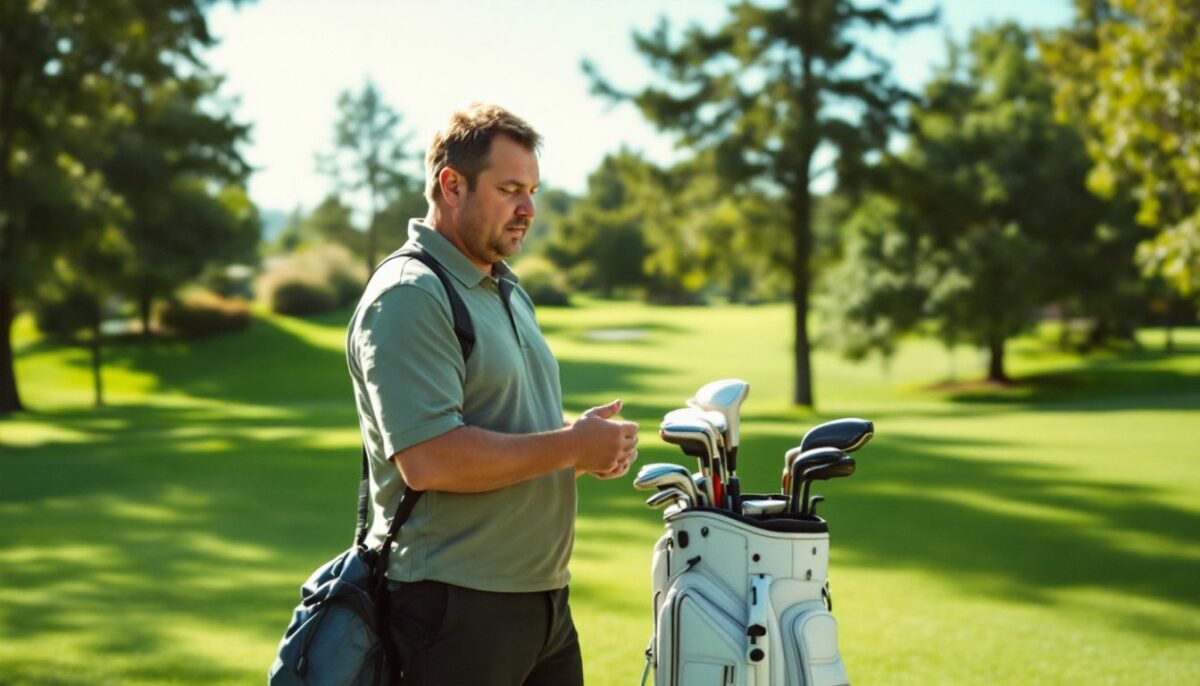
Picking the right golf bag can make your game smoother and more enjoyable. Each type offers different benefits, so choose one that suits how you play.
Cart Bag
A cart bag is heavier and built for golf carts. It offers spacious compartments, making it ideal for beginner golfers who prefer organization. These bags often include useful features like rain covers to protect clubs during bad weather and durable fabrics to handle wear and tear.
Most cart bags come with extra pockets for golf essentials. Players can store a golf towel, divot tool, snacks, or even their first aid kit easily. While they aren’t designed to carry around the course, they’re perfect for those sticking to a powered ride.
Carry/Stand Bag
Carry/stand bags are perfect for beginner golfers who enjoy walking the course. These lightweight golf bags typically weigh only 3–5 pounds, making them easy to carry during long rounds.
Built-in foldable legs let the bag stand upright wherever you stop, so no bending down to pick it up every time.
Newer models from just a year or two ago often offer great value without sacrificing quality or durability. Many include enough pockets for your golf essentials like tees, balls, gloves, and even space for snacks or a water bottle.
Comfortable shoulder straps help distribute weight evenly across your back, reducing strain as you move between holes.
Sunday Bag
Lighter than a carry bag, the Sunday Bag is perfect for short games or practice rounds. It holds about seven clubs, making it ideal for beginner golfers. Weighing between 4–7 pounds, it’s easy on the shoulders during long walks on the golf course.
Many beginner golf sets fit comfortably in this compact bag.
Its size encourages players to focus more on skill than equipment. Some models even come with a single strap and no stand, keeping things simple. Pair this bag with game improvement irons or forgiving golf clubs for an enjoyable day out.
Other Golf Accessories

Golf accessories are the unsung heroes of every game, adding comfort and ease—so let’s explore the hidden gems that make a difference.
Golf Glove
A golf glove improves grip and protects the non-dominant hand. It prevents blisters during long rounds on the golf course. Most beginner golfers benefit from a glove made of soft leather or synthetic materials, offering comfort and flexibility.
A well-fitted glove provides better control over clubs like drivers and irons.
Choose gloves with breathable fabric to keep hands dry in warm weather. Many players remove their gloves while putting or between swings for added comfort. Pairing a good-quality golf glove with other gear ensures an enjoyable game experience.
Now, let’s talk about another essential: a golf towel!
Golf Towel
A golf towel is a must-have for beginner golfers. It keeps clubs, hands, and even golf balls clean during play. Using dirty equipment can affect performance by reducing the clubface’s sweet spot or making grips slippery.
Beginners should carry two towels: one damp for cleaning dirt off clubs and balls and another dry for wiping hands or sweat. Clip one to the golf bag with ease of access in mind. A microfiber option works well because it absorbs water quickly without adding bulk.
Divot Tool
A divot tool is a must-have for any beginner golfer. It helps repair pitch marks on the golf course caused by ball impacts. These small tools keep greens smooth and ready for play.
Without them, damaged grass takes longer to heal, making it harder for others to enjoy their game.
Simple and compact, this tool easily fits in a pocket or golf bag. Using one shows respect for both fellow players and the course itself. Always have one handy next to your tees and ball markers—it’s as essential as any club in your beginner golf set!
Water, Snacks, and First Aid Essentials
Golf rounds can last several hours, often up to five. Staying hydrated and prepared is key for a comfortable experience on the golf course.
- Pack plenty of water bottles. Dehydration can sneak up during long rounds under the sun, so drink regularly.
- Bring healthy snacks like nuts, granola bars, or fruit. These keep your energy steady without weighing you down.
- Apply sunscreen with at least SPF 30 before starting. Reapply every two hours to protect against harsh UV rays.
- Carry a compact first-aid kit in your golf bag. Basic items like bandages, pain relievers, and antiseptic wipes can address minor injuries or blisters.
- Use a cooling towel during hot days. It helps keep you refreshed between shots while walking or riding in the cart bag.
- Don’t forget lip balm with SPF protection too. Lips are prone to getting dry and sunburned on open courses.
Golfing isn’t just about swinging clubs; preparation matters too!
Training Aids for Beginners
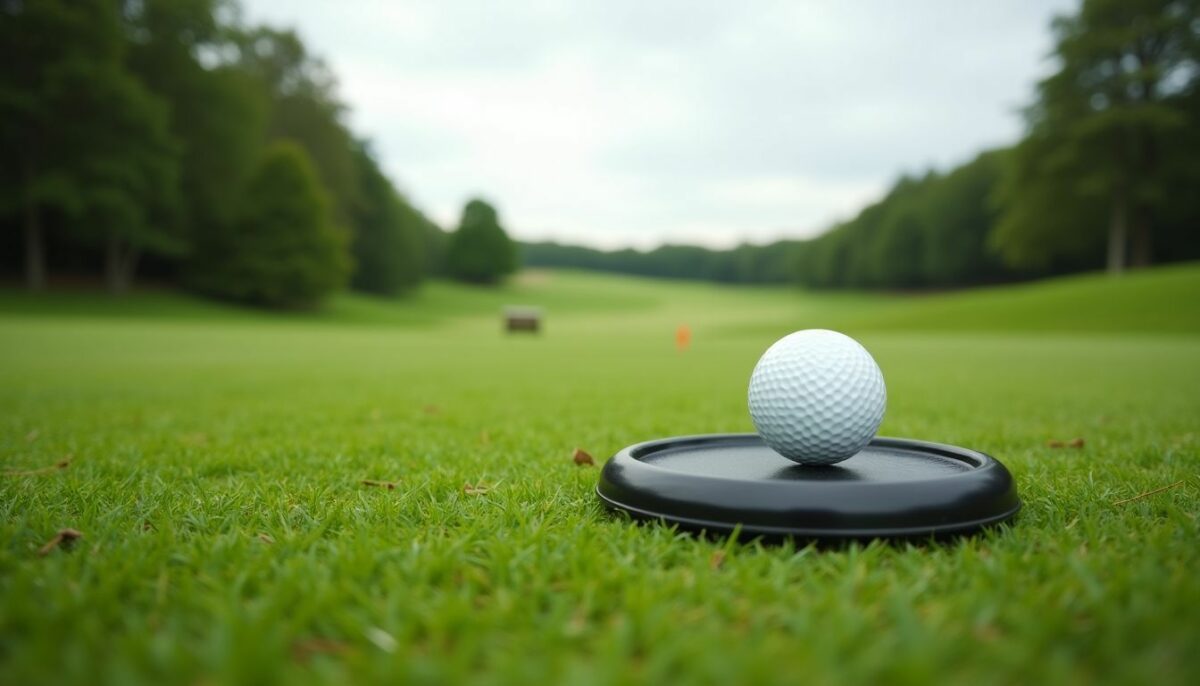
Training aids help new golfers improve faster. They make practice fun and boost confidence on the golf course.
Swing Trainers
Swing trainers improve a beginner golfer’s clubface control and grip. Tools like The Straight Stick are popular for refining swings. These aids help identify flaws, such as slicing or poor wrist alignment, by offering instant feedback.
Many models focus on boosting balance and creating muscle memory for a consistent swing. Some come with weighted features to strengthen muscles while practicing. Golf practice becomes more efficient with these tools, saving time on the course later.
Putting Mats
Swing trainers improve long shots, but putting demands precision. Putting mats bring the golf course right to your home. They help beginners build confidence, aiming skills, and a steady stroke.
Most mats mimic real greens with smooth rolls. Some even include markings for alignment practice or varying speeds for different challenges. A quality mat ensures every hit counts toward better accuracy on any actual green.
Tips for Choosing Affordable Equipment

Buying golf gear doesn’t have to break the bank. Smart choices, like used clubs or beginner sets, can save money without hurting your game.
Pre-Owned Clubs
Pre-owned golf clubs can save beginner golfers a lot of money. A full set of used forgiving golf clubs often costs less than $200, making them great for those just starting out. Many pre-owned options include game improvement irons or hybrids, which help hit the sweet spot more consistently.
These clubs are often in excellent condition and may even have graphite shafts for easier swings. Local pro shops and online stores offer plenty of options to choose from. Beginners should inspect the clubs carefully for damage and wear before buying.
Beginner Sets
Beginner golf sets are a cost-effective way to start playing. They often include essential clubs like a driver, fairway wood, hybrid, pitching wedge, sand wedge, and mallet putter.
These forgiving golf clubs help new players find the sweet spot more easily. Most beginner sets also come with a stand bag or cart bag for convenience.
These sets typically feature game improvement irons with graphite shafts. This makes swings smoother and less tiring for beginners. Brands like Wilson and Callaway offer great options without breaking the bank.
Investing in such sets saves time and reduces confusion about what’s needed early on in your golfing journey.
Conclusion
Starting golf can feel overwhelming, but the right gear makes it easier. Focus on essentials like simple clubs, sturdy shoes, and a reliable bag. Affordable options exist that won’t break the bank.
With this checklist in hand, any new golfer is ready for their first swing. Hit the course with confidence!
FAQs
1. What golf clubs should a beginner golfer start with?
Beginner golfers should look for forgiving golf clubs, like game improvement irons, fairway woods, and pitching wedges. These are easier to hit and help find the sweet spot more often.
2. Do I need both a cart bag and a stand bag as a beginner?
Not necessarily. A cart bag is great if you use a golf cart often, while a stand bag works well for walking the course. Choose one based on how you plan to play.
3. Are graphite shafts better for beginners?
Yes, graphite shafts are lighter than steel ones and make swinging easier for beginners who may not have fast swing speeds yet.
4. What other golf essentials do I need besides clubs?
You’ll need golf balls, tees, gloves (or at least one glove), proper shoes, clothing that’s easy to move in, and even small items like towels or scorecards.
5. Should I invest in specialized putters as a beginner?
Mallet putters can be helpful because they’re more forgiving than blade putters. They offer stability during your stroke—perfect when learning the ropes of putting!
6. Why is having the right equipment important for my first time on the course?
Using beginner-friendly gear like fairway woods or game improvement irons makes playing less frustrating and more enjoyable—plus it helps build confidence early on!

